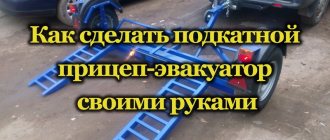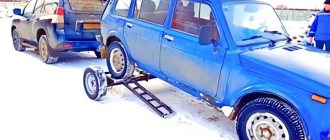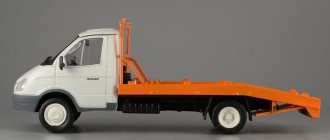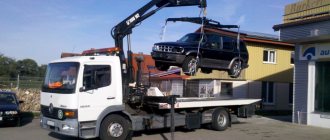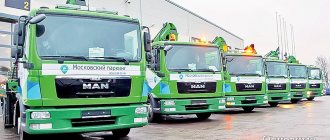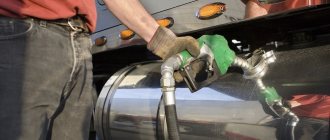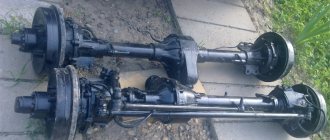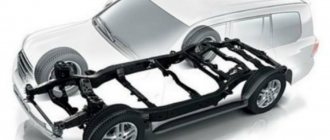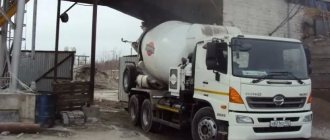Home → Evacuation with partial loading
Partial loading of a vehicle is carried out in those moments when it is impossible to completely load the vehicle onto the tow truck platform. It is necessary when the vehicle is heavily damaged or has a high weight, such as buses or trucks. Towing with partial loading will help you quickly transport your car to a service center.
We have renewed our fleet of tow trucks in 2022
Features and purpose
A tow truck, which allows partial loading of vehicles, is a narrow-profile type of towing equipment, during the use of which the transported vehicle maintains partial contact of the wheels with the road surface.
In this case, the vehicle is transported in such a way that one of the wheel axles continues to remain on the road, and the second is attached to the bridge or frame of the tow truck .
vehicle evacuation process
If for some reason the wheels of a faulty car are blocked or there are other reasons to prevent contact with the road, it is better to use a tow truck with a full loading of the car, carried out using a crane.
Nevertheless, in the conditions of large settlements and megacities, there is often a need to use a tow truck in some hard-to-reach places. This could be a busy street, an underground parking lot, a tight parking lot, or a courtyard. In such situations, special equipment with a broken platform may simply be unsuitable due to the lack of space sufficient to perform the maneuver.
Video: tow truck operation with partial loading
It is in difficult situations that a tow truck, which provides the possibility of partial loading, can solve the problem of a faulty or incorrectly parked car.
This type of towing special equipment has become widespread and used in various road services. Heavy-duty models of partial-load tow trucks are used to rescue relevant types of vehicles, such as minibuses, minivans, buses, light trucks and trailers.
In the case of removal of a vehicle with the handbrake on, special attachments are installed on the wheels and secured to the rear axle. These devices allow transportation without the risk of causing any damage due to wheel locking.
Common models
Popular tow truck models are ZIL, Scania, etc.
ZIL
The ZIL tow truck trailer is a unit with partial loading and a hydraulic manipulator. The device is installed on the basis of a four-axle all-wheel drive chassis (8x8). Suitable for removing heavy vehicles (buses, trucks), can work in difficult road conditions. Evacuation occurs by towing the vehicle's front axle. Additionally, the towing unit is equipped with two winches, which facilitates the operation of the unit. The stability of the structure is ensured by hydraulic rear supports.
Specifications:
- Load capacity - 3210 kg.
- Load moment - 28 t/m.
- Boom radius - 11.9 m.
The main structural element is the lifting boom, which is used to lift the vehicle axle and transport it using the partial loading method.
Scania
The tow truck is based on a four-axle chassis Scania P400 (8x4). This device can transport trucks and trailers. Evacuation is carried out by towing the front axle of the vehicle. When using additional options, you can evacuate vehicles using a rigid hitch. The lifting boom is the main structural element. With its help, the axle is lifted and the machine is transported.
Technical indicators:
- Loading capacity - 9 tons.
- The smallest boom radius is 3435 mm.
- The largest is 3435 mm.
The tow truck has a durable chassis, headlights, body kit with a compartment for tools. The boom is raised using two hydraulic cylinders on which hydraulic locks are mounted. At the back there is a pneumatic connector for connecting pneumatic tools.
Tow truck design
A tow truck that provides for partial loading of a vehicle differs from a similar vehicle with full loading by its reduced base length. Thanks to this, the maneuverability of the tow truck increases and its efficiency when performing work in the limited amount of available space characteristic of city streets and courtyards.
The movement of a faulty vehicle is carried out by lifting its front or rear axle onto the tow truck platform and securely securing it using special devices. At the same time, the wheels of the car, which are not secured to the platform, continue to come into contact with the road, as during normal movement.
Tow trucks with partial loading are equipped with a full set of equipment required for the reliable and safe transportation of a vehicle that is not completely placed on the platform. Manufacturers include the following devices and tools in this category of special vehicles.
- Electric or hydraulic winch.
- A set of adapters used when lifting and securing transported vehicles.
- Set of special grips.
The most important device used on such special equipment is the “steel goose” . This is a special unit that provides the ability to attach the front beam or rear axle of the transported vehicle. In addition, the list of required technical means and devices includes nozzles of various sizes and other additional elements.
The safety of placing the damaged vehicle on the site is ensured by rotating rollers with the ability to change the direction of the cable with your own hands.
How to make it yourself
To make the design you will need:
- square steel pipes;
- steel profile;
- bolts;
- fastenings;
- wheels;
- welding machine.
It is possible to make a collapsible tow truck structure. The length of the main pipe from the towbar to the rear frame should be 210 cm. The width should be 180 cm. The main pipe from above must be reinforced with a second square pipe. A winch is installed on a small hill, which helps to tighten the car.
The main pipe is secured with a bolt, and side braces 110 cm long are also installed. The braces are attached to the main pipe at a distance of 65 cm from the rear frame. At the frame joints, steel bolts are reinforced with a U-shaped profile 6x3 cm.
Wheels are installed using axles, hub bolts, and steel profiles. The vehicle will enter via two ramps, which are attached to a hook. The structure must be equipped with headlights. Before starting operation, you need to check all components and connections for strength.
Scope of application
A car or truck tow truck that provides partial loading can be used to remove a wide variety of vehicles in the most difficult situations and conditions. In particular, this type of car tow truck is the most effective (and sometimes the only one) when it is necessary to remove cars stuck in snow, mud, sand and even a swamp, as well as cars that have fallen through the ice.
If it is necessary to transport the vehicle, its frame and rear or front axle are lifted onto the tow truck platform using a special lifting device and secured with special fastening devices. In this case, the second bridge, which has a wheelbase, remains on the ground, continuing to interact directly with the road. It is in this “semi-suspended” state that the car is transported to its destination.
If the wheels of the towed vehicle are blocked by the handbrake or for any other reason, special wheel covers can be used for transportation. They are attached to the rear axle of the car, allowing the car to be transported without any associated damage.
However, a tow truck with a partial loading of a car is not recommended for transporting cars with wheel locks or serious damage received in an accident. In such situations, it is more preferable and safer to use special transport, which provides for evacuation with a full loading of the vehicle.
Partially loaded special recovery equipment can be used to remove not only cars, but also other types of cars and vehicles, including various special equipment, trucks of any tonnage, trailers and semi-trailers, buses, etc.
Towing using the partial loading method is
20.2(1) introduced by Decree of the Government of the Russian Federation No. 333)
20.3. When towing with a flexible hitch, the distance between the towing and towed vehicles must be within 4 - 6 m, and when towing with a rigid hitch - no more than 4 m.
The flexible link must be marked in accordance with paragraph 9 of the General Provisions.
(paragraph introduced by Decree of the Government of the Russian Federation No. 595)
20.4. Towing is prohibited:
vehicles that do not have steering control (towing by partial loading is allowed);
two or more vehicles;
vehicles with an inoperative braking system, if their actual weight is more than half the actual weight of the towing vehicle. If the actual weight is lower, towing of such vehicles is allowed only with a rigid coupling or by partial loading;
Systems that do not allow the driver to stop the vehicle or maneuver while driving even at minimum speed are considered inoperative.
two-wheeled motorcycles without a side trailer, as well as such motorcycles;
(as amended by Decree of the Government of the Russian Federation No. 1097)
(see text in previous)
in icy conditions on a flexible hitch.
Rules for towing a car
The ban on towing 2 or more vehicles applies to “Mechanical vehicles”
A trailer is a “Vehicle” - a device designed to transport on roads people, goods or equipment installed on it.
So I don’t think the inspector will get to the bottom of this, are there any other points here? If the ban applied to mechanical vehicles, then they would have written it that way.© 2011 - 2022 Team of the site PDDCLUB.RU (PDD CLUB.RU). All rights reserved. It is prohibited to use information from the site without the written permission of the authors.
Towing using partial loading method. Are there any traffic violations (photo)?
In addition, this equipment is equipped with additional equipment on the road - jacks and dollies. By the way, thanks to the latter, in some cases it is possible to evacuate a vehicle via partial loading routes even when both pairs of wheels are blocked or damaged. One pair of wheels is loaded onto the platform, and the second - onto the trolley. The carts also help when towing vehicles with all-wheel drive or an automatic transmission using this method.
Tow trucks for partial loading have a shortened platform, which increases their maneuverability and cross-country ability. At the same time, these machines have excellent power indicators. Such characteristics allow these vehicles to quickly arrive at the scene of an incident, even in heavy traffic during rush hours.
At the same time, evacuation by this method requires the performers to have high professionalism and experience, since improperly securing the car on the platform can lead to the creation of an emergency situation on the road during transportation and, ultimately, to even more serious damage to the car.
Using the partial loading method
As is known, the evacuation of vehicles can be carried out in three ways: towing on a flexible or rigid joint, full loading on a tow truck and partial loading. In this article we will look at the specifics of the latter.
In most cases, the partial loading method is used when the dimensions and weight of the towed vehicle are large, which does not allow it to be fully loaded onto a tow truck. This method can only be used when at least one pair of wheels is not blocked and undamaged.
The evacuation process by partial or incomplete loading occurs as follows. A tow truck approaches the damaged vehicle (or the car is pulled to it using a winch), after which, using lifting mechanisms, its front or rear (most damaged) part is raised and lowered onto the platform. This part is firmly fixed using special devices, and the other pair of wheels remains on the road. When the tow truck starts moving, it will move “under its own power.”
For this evacuation method, special tow trucks are used, which differ from ordinary ones in some features. They have the same platform as tractor-trailers and are equipped with additional mechanisms for lifting loads and grabbing wheels (hydraulic or electric winch, clamps, tightening belts).
transportation by partial loading method
transportation by partial loading method
I’m very interested in this question: I have a passenger trailer with a capacity of 400 kg. Everything is fine with the document. I drive the front of another car into it on two boards and tie it up, i.e. It turns out that I tow it using the partial loading method. The total weight of the road train does not exceed 3500 kg. The trailer has brakes, I am transporting a car weighing 1000 kg. Question one - it turns out half the car is on a trailer, i.e. 500 kg, overweight 100 kg, which is the maximum risk I face from this overload if the inspector sees it. The second question is whether they will deprive me of my rights for oversized cargo even if I hang up a sign for oversized cargo, and in general, what’s the worst that threatens.
I would be very grateful for clarification20.4. Towing is prohibited: two or more vehicles;
Article 12.21. Violation of the rules for the transportation of goods, the rules of towing 1. Violation of the rules for the transportation of goods, as well as the rules of towing, entails a warning or the imposition of an administrative fine in the amount of one hundred rubles.
I think this should be considered as towing. Transportation is when the cargo (car) is completely loaded into the body. But if the inspector stops you, he will force you to dismantle this shack. What will you do then? Article 20 of the Traffic Regulations https://pddmaster.ru/documents/pdd/20-bu ... -tekst-pdd is called: Traffic Regulations of the Russian Federation: 20. Towing of motor vehicles and “Motor vehicle” is a vehicle other than moped driven by an engine. The ban on towing 2 or more vehicles applies to “Mechanical vehicles”
A trailer is a “Vehicle” - a device designed to transport on roads people, goods or equipment installed on it.
so I think the inspector won’t get to the bottom of this, are there any other points here? fisher350 wrote: Article 20 of the Traffic Regulations https://pddmaster.ru/documents/pdd/20-bu ... -tekst-pdd is called: Traffic Regulations of the Russian Federation : 20. Towing of motor vehicles a “Motor vehicle” is a vehicle, other than a moped, driven by an engine.
